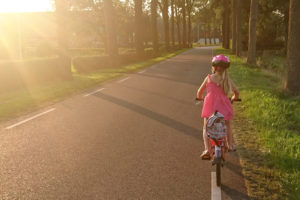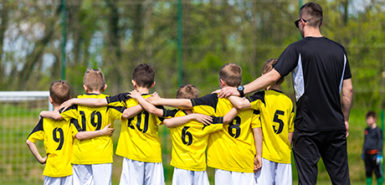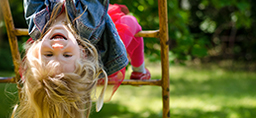
Playing sports offers plenty of fitness and other developmental benefits for kids, but injuries are common. Every year, more than 2.6 million U.S. children aged 19 and under are treated in the ER for sports- and recreation-related injuries.
If your child plays team sports, start by vetting the qualifications of the coaches.
Our Take
“Bike riding is a great family activity,” said Jennifer Hoekstra, program coordinator of Spectrum Health Helen DeVos Children’s Hospital Injury Prevention Program and Safe Kids Greater Grand Rapids.
Why wear a helmet?
Consider these facts about bicycles, kids and injuries from the Centers for Disease Control and Prevention and www.helmets.org:
- Helmet use is lowest (for all ages) among children ages 11 to 14.
- Bicycle helmets have been shown to reduce the risk of head injury and the risk of brain injury.
- The Center for Head Injury Services reports that 85 percent of all head injuries in bicycle accidents can be prevented by wearing a helmet.
- Bicycle helmets have also been shown to offer substantial protection to the forehead and midface.
- Universal use of bicycle helmets by children ages 4 to 15 could prevent between 135 and 155 deaths, between 39,000 and 45,000 head injuries, and between 18,000 and 55,000 scalp and face injuries annually.
- Child helmet ownership and use increases with the parent’s income and education level, yet decreases with the child’s age.
- Children are more likely to wear a bicycle helmet if riding with others who are also wearing one.
- In a national survey of children ages 8 to 12, 53 percent reported that a parental rule for helmet use would persuade them to wear a helmet, and 49 percent would wear a helmet if a state or community law required it.
Bicycle helmet use by every rider, of every age, for every ride should be every family’s rule.
A questionnaire-based study by the American Council on Exercise found common knowledge gaps among youth-sports coaches—many of whom are volunteers—in the areas of proper hydration, strength training, nutrition and concussions. For instance, many didn’t know about “second impact syndrome”—when a second concussion occurs before the first one has healed, a potentially fatal situation.
Make sure your kids learn and practice skills they need for their sport. Proper form helps prevent injuries. If your child isn’t in condition for the activity or is new to it, he or she needs to start slowly, ideally by preparing in the off-season for at least four weeks. Developing strong legs in particular will help protect knees and ankles.
Check that your young athletes have—and wear—properly fitted protective gear appropriate for their activity, such as helmets to prevent concussions, wrist guards, knee or elbow pads. And regularly check that the equipment is in good condition.
Wearing a helmet is a must for:
- Batting and running bases in baseball or softball.
- Playing a contact sport, such as football or hockey.
- Riding a bike, snowmobile or ATV.
- Skiing and snowboarding.
- Using inline skates, a skateboard or scooter.
- Horseback riding.
Also, pay attention to the weather. Kids need time to adjust to heat and humidity when playing outdoors to avoid both injury and illness. Make sure they drink the right amount of water and are dressed for the conditions.
 /a>
/a>
 /a>
/a>
 /a>
/a>